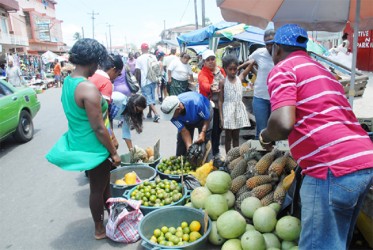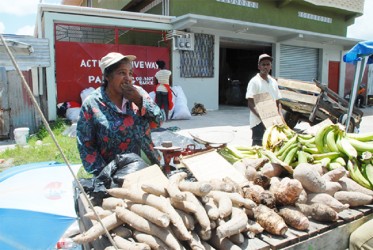For sheer congestion and chaos the Sunday morning La Penitence Market is unmatched in the capital and its environs. Like the Sunday market at Plaisance it spills over onto the street, except that in the case of Plaisance vehicular traffic moves in one direction only, south towards the Cheddi Jagan International Airport and Linden, albeit at a painful crawl.
The entire expanse of the public road that extends from the Ruimveldt Police Station to Sussex Street has to be cordoned and traffic heading for Georgetown redirected onto Lombard Street. Traffic moves gingerly in one direction, south.
La Penitence is the least celebrated of the three markets in the city and yet, at its Sunday peak it possesses a character that outstrips the others. On Sundays it becomes the focal point of commerce along the entire stretch of road that extends onto the East Bank Highway.

The spectacle of Sunday is usually preceded by the rather more sedate arrival of the earliest waves of vendors on the previous Saturday. They arrive by boat from a host of communities west of the Demerara River: Canals Number One and Two and Zeelugt, being among them. Those vendors from this side of the river, from Enmore, Bee Hive, Mahaica, Victoria, Cane Grove, Ann’s Grove on the East Coast Demerara and from Linden, the Soesdyke-Linden highway arrive by minibus or Canter early the next morning. There are traders from Albous-town, Alexander Village and elsewhere in Georgetown too who come along too. They arrive at different times, exuding a sense of urgency, arranging their goods with a sense of diligence, anticipating a busy trading day. On Sundays, this market is an important economic hub and a hectic trading space.
Among the earliest customers are churchgoers on their way home from early morning worship. Their ‘Sunday best’ clothing is a dead giveaway. Taxi drivers too are among the earliest patrons.
Sunday is not the best day for journalists to talk with market vendors. It is their best trading day and questions and cameras are a compelling distraction. You have to learn to put up with long delays between questions and answers. One vendor told us that the third and fourth Sundays in the month were usually “good days, busy days,” not days to “hang about”. There is little or no business to be done here on weekdays. We were at the market on the third Sunday of the month.

Alvin Rambarran is a talkative ground provision seller. On weekdays, he says, he may sometimes sell ten pounds of cassava. On Sundays he sells around one hundred pounds without really trying. Every Sunday he purchases ground provision from the farmers that arrive from Linden. When we caught up with him he was close to selling out and was focused on getting home.
That day, boulanger was being sold at a wholesale price of $6,500 per bag; that worked out to a retail price of three boulangers for $200. Plantains were available at a wholesale price of $60 or $70 per pound and retail between $80 and $100. On Sunday there was evidence of a brisk retail trade in plantains. Not so sweet potatoes; the retailers appeared to be making a killing, retailing at $120 per pound. Cassava, usually the most reasonably priced of ground provisions, was being sold at a wholesale price of $30 per pound and retailing at $60 per pound.
Fruits appeared to have settled at the other extreme of the price range. Water melon was being sold at $200 per slice. A family person wanting a whole melon had to be prepared to part with around $1,000. Cucumbers were being sold at $60 each, a high price considering the customary market prices. Some fruit, however, appeared to be reasonably priced. ‘Long’ limes were being sold at 10 for $100; lemons, three for $200; pineapples, two for $500 – a steal according to one vendor; oranges, four for $100 and tangerines also four for $100.
The price of $100 per pint for pepper prevailed for several weeks and on Sunday you could by two attractive heads of lettuce for $100.
Among other fruits and vegetables, bora was being sold at $1,000 per bundle, or retailed at three parcels for $200. Three dried coconuts could be had for $100, and ochro was being retailed at $140 per pound.
There was meat in evidence too: pork at $500 per pound and plucked duck at $700 per pound. Those interested in rearing ducks could buy two at La Penitence Market on Sunday for $1,500.
The interaction between buyers and sellers revealed that it was one of those ‘mixed days’ when the good prices balanced out the ‘bad’ ones.

Conversations with market vendors can be absorbing encounters. Their itineraries can be bewilderingly hectic. Those who catch the Sunday windfall at La Penitence must also settle for the less lucrative trading environment of the weekday market at other municipal spaces.
“De hustle don’t stop,” Ann says. She had sold plantain chips for a number of years. Then she became ill and her doctor had told her to “stay away from the heat.” These days, on Sundays, she sells shoes, slippers and clothing bought mostly from the Chinese stores. On weekdays she trades on Regent Street. However, she says that with the back-to-school trading period having just come to an end business on Regent Street was slow. Ann and other vendors with whom we spoke on Sunday are hoping for a “good hustle” outside the Sophia pavilion during GuyExpo. Ann travels to the New Amsterdam and Linden Town days to ply her trade too. Water and aerated beverages are good sellers at those events.
For the past 30 years Anita Charles has been making the trek from Victoria to the La Penitence Market to sell coconut water, fruits, cassareep, achar and pepper sauce. Hard work and exposure to inclement weather have taken their toll. Her feet pain constantly and she is now at the market less frequently. Sundays, however, are “a must”.
The vendors have their trials. They complain about wholesalers who sell to them at a particular price then proceed to retail the same commodities in the same trading space at the same price. What that effectively means is that they are competing with the vendors. They do not think that the wholesalers should occupy the same space. Anita chimed in to make the point that she had had to resell the star apples which she had bought earlier at the same price.
Other vendors are more fortunate. A woman from Canal Number One was offering chicken reared at her own farm. Her price was competitive and she was obviously doing brisk business.
Some of the vendors concede that their efforts at rearing poultry had failed. They had simply been ‘trying their hands’ and the initiatives had failed for lack of both finances and expertise. It appeared too that their condition of poverty has made them afraid of incurring debts.
Every municipal market has its own colourful characters. Jennifer Petrie calls herself the ‘Shopping Mall Lady’. The sobriquet is not misplaced. She trades from a handcart which is usually laden with goods of all descriptions. Jennifer lives in Albouystown and under normal circumstances would store her goods at home. The cart, however, cannot pass through her door so she has made storage arrangements at premises on D’Urban street. Every Sunday morning she pushes her laden cart to La Penitence Market. That in itself is a spectacle.
A year ago she was trading chocolate sticks from the North West District. Then she moved up to spices: cinnamon, cloves, nutmeg, anise and blackpepper; bags; notebooks and Epsom salt. These days she trades in whatever her customers buy. She purchases from stores around town and sometimes gets barrels from Canada.
Among the vendors it is not difficult to detect a compulsive entrepreneurship. That spirit, however, is lacking in the refinements associated with the growth of sustainable business enterprises. The fact that they have remained ‘in the game’ is clearly a function of grit and determination and remaining focused.
Midday comes quickly at the market. The municipal authorities frown on the vendors exceeding the designated trading period even though the culture allows for some flexibility. By 11.30 the preoccupation among the vendors begins to focus on selling out and going home. Buyers begin to look for bargains. Prices tend to come down as midday draws closer. Where the vendors are disinclined to drop prices you simply enter into brisk negotiations with them.
There are other traders in the vicinity who take advantage of the large gathering of buyers at the market. There is Twins Drug Store which has been part of the market forever.’ On the opposite side of the road there is an assortment of coconut vendors, cigarette trays and people doing brisk business in cold aerated beverages, cane juice, cigarettes and confectionary. The Sunday Market provides commercial opportunities for a variety of traders and many of them have been trading here for years.
As the market wound down there were snatches of conversation with a number of traders like the family from Enmore offering greens and vegetables; Alfred Powley, the coconut vendor and Dinesh, a ground provision seller from Albouystown. The vending trade is filled with absorbing stories of lives and fortunes that have swayed in myriad directions. The vendors have their own wishes and dreams, like those that have to do with securing loans to create their own shops or to simply cut out the middleman by starting farming enterprises of their own. The retailers feel vulnerable in the face of the inexorable rise of those whose farming pursuits allow them to trade at more competitive prices. Krishna lives in Mahaica, runs his own farm and understands how to keep his prices below those of the competition.
Then there are the myriad hustlers, the Sunday Market ‘hoppers’ who simply go with the flow, trading at one Sunday Market or another. They have worked out their own patterns that have to do with where, during any particular period, the competitive advantage lies. On the whole, this sort of itinerant trading is a phenomenon which attracts far less official study than it deserves. Not only does it account for a significant number of jobs but it also reflects the unending hustle which, in a considerable number of cases, is inextricably linked to people’s survival. There are significant numbers of clothing vendors at the La Penitence Sunday Market. It is a growing component of overall retail trade, reflecting, simultaneously, a growth in the supply of articles of clothing in barrels from abroad and an increase in the number of ordinary whose circumstances make used clothing an appealing prospect. Some of the clothing vendors regard the advent of the Chinese traders as a mortal threat to their own pursuits.
Midday comes and the market is reduced to a crawl. The traffic begins to flow again like a waterway that has just had a collection of garbage removed. A handful of sellers and buyers persist, the former group now frantic to part with what is left of their goods. Prices have reached rock bottom. It has become a matter of throwing nothing away. A much smaller, eager-eyed group of buyers now move from, stall to stall negotiating. That process will persist for some time yet.






